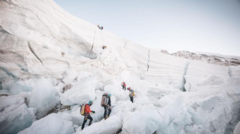Nepalese climber Kami Rita Sherpa, widely recognized as "Everest Man," has shattered his own record by reaching the summit of Mount Everest for the 31st time. The accomplished 55-year-old, who was leading a group of Indian army personnel, successfully attained the 8,894-meter peak at 04:00 local time on Tuesday (23:15 GMT Monday).
Expedition organizer Seven Summit Treks hailed Sherpa as both a "national climbing hero" and a "global symbol of Everest". His journey to the top began in 1994, and he has made the ascent nearly every year since then, sometimes completing as many as two climbs in a single year. His closest rival, Pasang Dawa, has reached the summit 29 times, most recently last week.
Despite the honor of setting a new record, Sherpa remains grounded about his achievements. "I am glad for the record, but records are eventually broken," he stated in a previous interview. His primary motivation, he emphasizes, is the recognition it brings to Nepal on the world stage.
In addition to reflecting on his climbing career, Kami Rita has also shared insights into life on Everest, including cultural aspects such as the Puja ceremony, a Tibetan Buddhist ritual performed before climbs to invoke safety and success.
His recent climb came shortly after British mountaineer Kenton Cool achieved his 19th successful summit, marking a record for non-Sherpa climbers. This climbing season has seen more than 500 climbers reach the top of Everest, following the issuance of over 1,000 climbing permits by Nepal's tourism department. While the number of summits has sharply increased, it has also raised concerns about overcrowding and environmental repercussions, leading to new regulations for waste management on the mountain.
As climbing activity intensifies, the environmental and logistical implications of this trend remain a significant topic of discussion among climbers, officials, and the global community.
Expedition organizer Seven Summit Treks hailed Sherpa as both a "national climbing hero" and a "global symbol of Everest". His journey to the top began in 1994, and he has made the ascent nearly every year since then, sometimes completing as many as two climbs in a single year. His closest rival, Pasang Dawa, has reached the summit 29 times, most recently last week.
Despite the honor of setting a new record, Sherpa remains grounded about his achievements. "I am glad for the record, but records are eventually broken," he stated in a previous interview. His primary motivation, he emphasizes, is the recognition it brings to Nepal on the world stage.
In addition to reflecting on his climbing career, Kami Rita has also shared insights into life on Everest, including cultural aspects such as the Puja ceremony, a Tibetan Buddhist ritual performed before climbs to invoke safety and success.
His recent climb came shortly after British mountaineer Kenton Cool achieved his 19th successful summit, marking a record for non-Sherpa climbers. This climbing season has seen more than 500 climbers reach the top of Everest, following the issuance of over 1,000 climbing permits by Nepal's tourism department. While the number of summits has sharply increased, it has also raised concerns about overcrowding and environmental repercussions, leading to new regulations for waste management on the mountain.
As climbing activity intensifies, the environmental and logistical implications of this trend remain a significant topic of discussion among climbers, officials, and the global community.


















